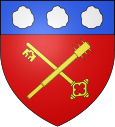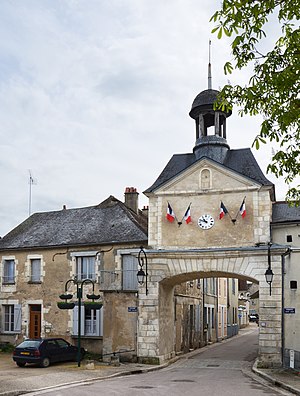Cravant (Yonne)
| Cravant | ||
|---|---|---|

|
|
|
| local community | Deux Rivières | |
| region | Bourgogne-Franche-Comté | |
| Department | Yonne | |
| Arrondissement | Auxerre | |
| Coordinates | 47 ° 41 ′ N , 3 ° 42 ′ E | |
| Post Code | 89460 | |
| Former INSEE code | 89130 | |
| Incorporation | January 1, 2017 | |
| status | Commune déléguée | |
| Website | http://www.cravant-yonne.fr/ | |
 Porte d'Orléans lower city gate |
||
Cravant is a commune Déléguée in the French community Deux Rivières with 814 inhabitants (at January 1, 2017) in the Region Bourgogne Franche-Comté in the Yonne department .
On January 1, 2017, the municipality merged with Accolay to form the Commune nouvelle Deux Rivières . The municipality of Cravant was assigned to the canton of Vermenton and the arrondissement of Auxerre .
geography
The place is 18 kilometers south of Auxerre on Route nationale 6 . In Cravant the Cure flows into the Yonne . The Canal du Nivernais runs through the former municipality .
The numerous limestone quarries on the edge of the village, known under the name Carrières de la Palotte , are striking . It is an underground complex of almost 35 hectares , which includes three cave passages and as many main galleries almost 20 meters high.
history
Surname
Cravan (t) is a Celtic combination of words. As the original Cor-Ban , the name was Latinized during the Gallo-Roman period , with the usual sound shift from b to v . Cor means “confluence”, Ban “castle”. Cor-Ban is the settlement where the Cure flows into the Yonne. The following toponyms are known: Crevennum or Crevannum in the 9th century, Crevan from the 17th to the 18th century and finally Cravant .
timeline
A royal letter from 1384 describes Crevan (t) as "the first port on the Yonne where the wines from Beaune and Burgundy are shipped for the Paris market." In the same year, King Charles VI. permission to fortify the city to protect trade. The outer fortification originally consisted of a city wall (only the remains of which are still clearly visible today) and three city gates and the castle with a donjon . The lower city gate was called Porte d ' Orléans , the upper Porte de la Poterne and the side - after a former hamlet - Porte d'Arbaud (also spelled Porte d'Arbault ).
In the course of the Hundred Years' War on July 31, 1423, the allied troops of the French King Charles VII and the Scottish King James I advancing from Bourges were defeated in the Battle of Cravant by the English who had come from Auxerre and were allied with the Duchy of Burgundy . Together with the French defeat at the Battle of Verneuil a year later, this resulted in the still young Charles VII being driven back with his army behind the Loire and ridiculed as "the little King of Bourges".
Limestone was extracted for construction in the Palotte quarries for almost 800 years and until 1935 . At the beginning of the Second World War , an underground aircraft factory was set up here, which initially assembled the French LeO 45 bomber . After the victory of the German Wehrmacht over France, the occupiers used the factory as a maintenance facility for their Focke-Wulf Fw 190 fighter aircraft .
From 1941 to 1944, the German occupying power operated a concentration camp for prisoners of Jewish origin from Germany who had to mine limestone in another part of the quarries . Two of them who managed to escape later donated a votive tablet in the small suburban church of Notre Dame d'Arbaud . Because of the Allied landing in Normandy and their advance, the concentration camp was evacuated in August 1944 and the Wehrmacht withdrew. Nevertheless, another 70 copies of the Focke-Wulf could be assembled under the designation NC-900 and given to the Escadrille française Normandie-Niémen .
After the end of the war, the factory was finally closed on February 18, 1946.
Population development
In 1866 the community still had more than 1,300 inhabitants. The number fell to around 800 during World War I and has stagnated since then.
| year | 1936 | 1946 | 1954 | 1962 | 1968 | 1975 | 1982 | 1990 | 1999 | 2008 |
|---|---|---|---|---|---|---|---|---|---|---|
| Residents | 726 | 776 | 750 | 747 | 755 | 748 | 756 | 794 | 824 | 808 |
Attractions
- The Saint-Pierre-Saint-Paul church dates back to the 14th century, but was later changed several times. The choir , the three-story bell tower and the coffered ceiling are from the Renaissance . The building has been a listed building since 1906.
- The Tour de l'Horloge clock tower (also known as Beffroi de Cravant or Tour du Guet ), originally from 1387 and a listed building since 1926, stands in the upper part of the village.
- The oldest of several half-timbered houses dates from the 16th century.
- The castle has an impressive defense and residential tower .
- Remains of the old siege ring have been preserved. The moat was filled in and turned into a walkway.
- At the exit of the village in the direction of Irancy there is a viewpoint above the vineyards with a view over the Yonne valley with the cities of Clamecy and Vézelay and the Cure valley with the city of Avallon .
Viticulture
Cravant has a stake in the Côte de Palotte , a growing area that produces the light and fruity red and rosé wines that are marketed under the Irancy AOC Denomination of Origin . In addition, the regionally widespread Burgundy wines Aligoté , Bourgogne Grand Ordinaire , Crémant de Bourgogne and Passetoutgrain are grown in Cravant .
Personalities
- Léon Breton (1861–1940), cycling official and entrepreneur
Web links
Individual evidence
- ↑ Annuaire historique du departement de l'Yonne , Vol. 4, p. 63. Reboul et Ed. Perriquet, Auxerre, 1840.
- ↑ Annuaire historique du departement de l'Yonne , Vol. 11, p. 14. Ed. Perriquet, Auxerre, 1847.
- ↑ a b Albert H. Keil: "Nobody came to help." Mußbach and the "brown plague" . In: Marita Hoffmann and Bernhard Kukatzki (eds.): “At dawn on March 18, 1945, there was still dead silence.” At the end of the Second World War in the Palatinate . Special issue (= Palatinate-Rhenish family history ). tape XVIII , no. 8/9 . Verlag Llux, Ludwigshafen 2016, ISBN 978-3-938031-72-8 , p. 99-103 ( online ).
- ^ Arbaud votive tablet. → Verlag PfalzMundArt , accessed on July 16, 2018 .
- ^ L'usine souterraine aeronautique de Cravant au coeur de la guerre 1939–1945 . Brochure, AVIATROGLO, 2006.





